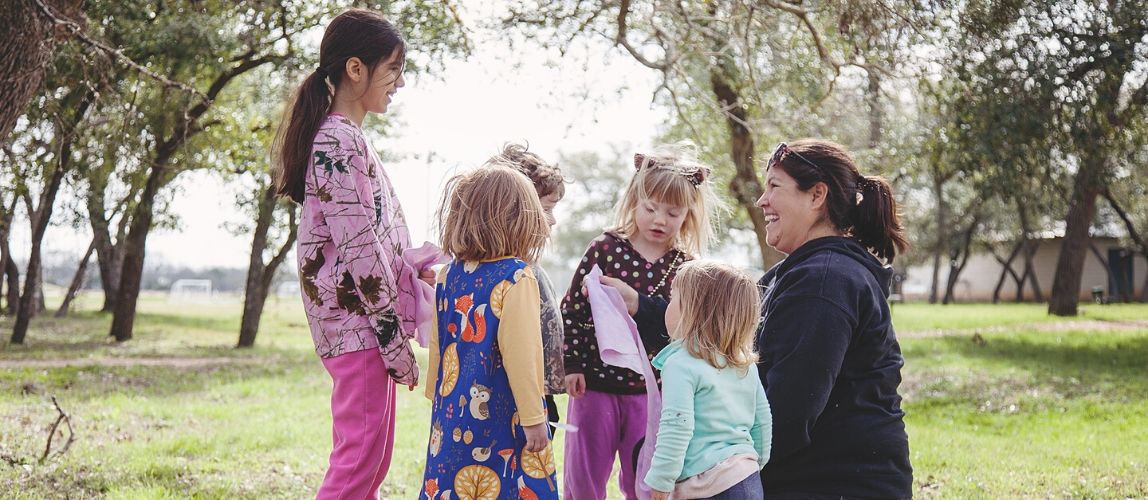Max’s mom caught me off guard when she asked to enroll her 2-year-old in my very first “3 to 5-year-old” Tinkergarten class. I wondered how such a mixed age group would feel to kids and, even more so, to parents. Ultimately, I gave it a try.
That season, I was amazed by how much Max was able to do. Although Max took longer than his older classmates to come out of his shell, the older kids watched out for him, and he responded to their attention and modeling. In little time, Max “joined the pack,” pretended quite readily, and took on remarkable challenges. What blew my mind was how much the older children seemed to gain from both caring for Max and making him their genuine playmate.
Years later, all of our learning groups at Tinkergarten span far more than three years of age, thanks to that experience and so much learning. In fact our core program is designed to fully support kids ages 1.5 through 8 years of age.
None of this should be too surprising. If you have multiple kids or a large extended family, you regularly see the beauty of younger and older playing and learning together. Find a way to watch To Be and To Have, a gorgeous film about a French one-room schoolhouse, and you’ll feel it in your bones. Humans were learning in mixed-age groupings for centuries, and anthropologists like Melvin Konner remind us that same-aged learning groups are a construct of modern times. Still, nearly all learning experiences in today’s world group kids in very narrow age ranges.
The Power of Mixed Age Play
Ready for a laugh (and maybe a little learning)? Take a look at this 2 minute look at mixed age play:
Good for the Wee Ones
According to evolutionary psychologist Peter Gray, age mixing stretches younger children so that they can play in more advanced ways than they could with their same-aged peers. Young children also flourish socially under the care and emotional support of older, more experienced children. Research shows that mixed-age play with older playmates supports enhanced cognitive, language, and motor development in 2-year-olds.
Parents understandably worry that a mixed age experience is too advanced for wee ones. Younger children often appear less engaged since they take a bit longer to adapt to a new classroom, shift focus often, and express their ideas in less sophisticated ways than their elders.
Nevertheless, younger children take in so much information, and learn from what they observe. If we stop thinking of the older children as yardsticks against which to compare a younger child’s play, we can see older children as teachers who can scaffold a younger child’s learning. When we allow young children to take their time, and look for evidence of learning both in and outside of class, we nearly always see young children making remarkable progress.
Benefits to Older Kids,Too
Mixed-age play also benefits the older kids. Playing with younger children gives them the chance to act as leaders, to play teacher, and to develop creativity, empathy, and kindness—soft skills that kids need as they make and maintain friendships, work and collaborate with others, and solve complicated problems. Playing with younger children does not “dumb down” the play of older kids. When 5 and 2-year olds play together, the 5-year-olds continue to play in their way; they just lift the 2-year-olds up with them.
Encouraging older kids to play with toddlers may not immediately appeal to parents of the older children. After all, it would seem that such play may not be as stimulating as play with same-age peers. Our culture has convinced us that stretching our kids to achieve as much as they can, as early as they can, will net better results. But it's critical to give our children this chance to work in mixed-aged groups. Kids learn to be leaders when they can be the most competent in the group, because they confidently share, and teach, and empathize with the younger ones.
In mixed-age, play-based settings, kids undergo real transformations: Younger children rise to meet their elders and older kids become leaders. Kids rarely get those chances in a same-age world. Letting our children experience rich, mixed-aged play is powerful, even essential for them in their early years, and may be one of the most valuable gifts we can give them.

